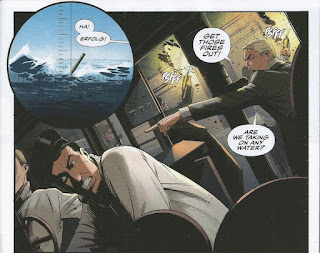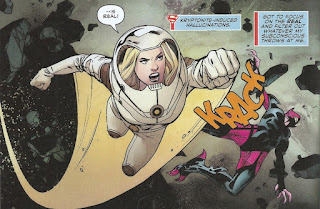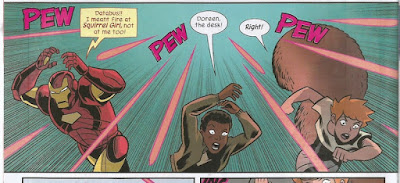Pick of the Brown Bag
December 13, 2018
by
Ray Tate
Flummoxed by the sheer volume of comic books last week. The POBB despite multiple attempts failed at presenting the reviews each book needed. Therefore, I chose to swallow my pride and make it a two parter.
This combo platter of POBB includes Albert Einstein Time Mason, Bitter Root, The Hellboy Winter Special, James Bond Origin, The Lone Ranger, Megaghost, Mystery Science Theater 3000, Outer Darkness and Peter Parker the Spectacular Spider-Man. If you have no time for the blog, you can find fresh teensy reviews on Twitter: #PickoftheBrownBag.
Peter Parker the Spectacular Spider-Man once again dips into Spider-Geddon territory without losing entertainment value. That’s probably because the threat is very easy to understand. Michael J. Straczynski and John Romita Jr. updated Morbius, the living vampire, and rechristened him Morlun.
The differences between Morlun and Morbius are vast. Though both vampires, Morbius drains only blood. Morlun saps living energy. Though neither are undead, Morlun is an alien predator. Morbius an altered human scientist. Morbius tangled with Spider-Man but he harbored no deep-seated hatred for the Web-Slinger. Morlun despises Spider-Man, and that’s because Spidey bested him. Chalk up another victory over arrogance and stupidity.
Morlun is a lot like Wile E. Coyote, and Spider-Man’s Roadrunner humiliates him. Spidey cheats like a dickens and times his tactical gags expertly. The truth is that Spidey could have stayed in hiding and attacked Morlun for the entire four pages necessary to dish out a well-deserved beating. If not for the aid of New York’s finest.
Because Spidey doesn’t want to see the NYPD diced in the process of doing their sworn duty, he must emerge from cover and attack Morlun directly. This is the only shot Morlun gets, and he fails miserably. Spidey just creams him in a barrage of hilarity.
Hellboy’s Winter Special is an anthology. Anthologies can of course be mixed bags, and Hellboy anthologies are really no different. Happy to say. All the stories in this issue are entertaining, with an equivalency of art and writing.
The first tale is a Mignola, Ben Stenbeck seance that presents a classic Hellboy whose youthful vigor come afore in a want to beat up monsters.
The second short is somewhat undefinable. Written and Illustrated by Gabriel Ba’ and Fabio Moon the fable begins with a folk agricultural ritual performed by humans in masks.
Interested parties voice their opinions on the efficacy of the practice. A stylish dude riding a bear that's not a bear shows up to add to the weirdness. You’re either going to dig the narrative or not. I thought it was creative and riveting.
In the third slot, a group of gunsels get the bad, seriously bad idea to frame pulp hero Lobster Johnson for various murders of rival gangs. It does not work out for them at all, but the reader will thoroughly enjoy Tonci Zonjic’s "Empty chair," definitely Shadow-like in tone.
The second issue of Bitter Root picks up where the first left off. Ford Sangereye emulates writer David Walker’s other subject John Shaft as he takes down the Klan before they can lynch an innocent man. There’s just one twist in this match that I shan’t reveal.
Ford escorts his charge back home. There he enjoys the hospitality of the would-be victim's parents. He distinguishes his method of combatting evil from his brethren Sangerye, who have their own problems.
Their rescue of the transformed turns when an even bigger threat manifests. At the same time, Walker, Chuck Brown and Sandford Greene also have fun with a staple of the period, the comedic double-act. Here essayed by the two cops. I can almost hear Mantan Moreland speaking one set of lines.
In the final pages, Dr. Kinitra Brooks contributes an essay about the heart of Bitter Root while John Jennings spotlights black scholar Alain LeRoy Locke and his effect on African-American Culture.
In the final pages, Dr. Kinitra Brooks contributes an essay about the heart of Bitter Root while John Jennings spotlights black scholar Alain LeRoy Locke and his effect on African-American Culture.
What would happen if H.P. Lovecraft lived long enough to meet up with Hanna and Barbera? Suppose also they hit it off. You would soon get a Cthulhu influenced cartoon like MegaGhost.
Set in the infamous Dunwich Heights, guilt by association, young Fausto Fitzwinkle challenges Martin Magus with a decidedly familiar wager.
Set in the infamous Dunwich Heights, guilt by association, young Fausto Fitzwinkle challenges Martin Magus with a decidedly familiar wager.
The dare leads to Magus discovering a ring, cursed with the ability to summon spirits. Not just any spirits. Together, like Voltron, they form MegaGhost, the figure on the cover.
When the formation happens, you can almost hear the Hanna-Barbera sound effects. The twisted Frankenstein Jr. reimagining follows through when MegaGhost battles a well known Lovecraft kaiju creature.
So, far so, innocent, but writer/creator Gabe Soria and artist/creator Gideon Kendall pay homage to the master of macabre more than standards and protocols might have allowed. Magus must perform ritualized magic before MegaGhost can be summoned. The ghosts aren't telling Magus the entire truth, and there's the promise of madness should Magus know all, a common malady of Lovecraft heroes. Though not assured. The creators of this ripping yarn also pull from other sources like Hammer's Dracula A.D. The ghosts namecheck or visually allude to the works of Shakespeare and Poe.
So, far so, innocent, but writer/creator Gabe Soria and artist/creator Gideon Kendall pay homage to the master of macabre more than standards and protocols might have allowed. Magus must perform ritualized magic before MegaGhost can be summoned. The ghosts aren't telling Magus the entire truth, and there's the promise of madness should Magus know all, a common malady of Lovecraft heroes. Though not assured. The creators of this ripping yarn also pull from other sources like Hammer's Dracula A.D. The ghosts namecheck or visually allude to the works of Shakespeare and Poe.
In the second issue of The Outer Darkness Joshua Briggs, Captain of The Charon gets to know his diverse crew.
This isn’t you’re average science fiction crew filled with aliens and humans. The Outer Darkness adds supernatural occupations and attributes some of the most powerful occult-fighting to exorcists and mathematicians. The latter is clearly a reference to the reality of the universe being described by maths. It ties in with the Theory of Everything. The concept that if you just knew the right formula you can unite classical physics with quantum physics.
In this respect the creatures of Outer Dark take on a Lovecraftian ambiance. Lovecraft's monsters are metamorphosed humans and aliens of an indescribable nature. The way the beings break apart physics willy-nilly is a horrible reminder of how tiny our brains.
Briggs takes The Charon into a region of space known for its sorcerous fibre. He watches the crew go to work, combatting monsters and weird events. It's an overt Herculean trial and offers Briggs Sadistic pleasure.
Outer Darkness is a showcase of Afu Chan’s horror-drenched art, and while Layman's plotting is thin, the way he builds on the elements in this strange, weird cosmos more than makes up for it.
Albert Einstein Time Mason takes up where we left off, Einstein duels Alexander the Great. This fight brought to you by complete misunderstanding.
Sponsored by a time traveling Nazi. In a bid to steal a cosmic stone Alexander used in his fabled gates. Gates that have a basis in historical reality.
The hunt for the more of the same stone and the Nazi takes Einstein to the Old West, where mayhem, science and spice ensue.
Time Mason beautifully illustrated, preposterous and utterly entertaining.
Mystery Science Theater continues its three serials through the comics of yore. Tom Servo is the Teen Reporter in a soap opera riff.
Jonah, Dr. Forrester’s human lab rat, teams up with the original Black Cat from the nineteen forties.
Crow replaces the Crypt Keeper for another done in one horror story. Sharp-eyed MST3K fans will smile at a long-running joke from the show.
Each tale is ripe with riffs and sight gags. Practically every panel is laugh out loud funny, and as these examples show, many of the jokes poke fun at normal comic book techniques, like foreshortening and artistic emphasis.
“Now, return with us to those thrilling days of yesteryear…” The Lone Ranger was mainly a western themed mystery show.
The Ranger would often employ disguise—usually a cantankerous old prospector—to gather evidence to capture a murderer or murderous gang.
He would sometimes broaden his scope to broker peace between natives, often scapegoated, and white settlers. Which is not to say that The Lone Ranger wasn’t an action oriented show.
The Ranger and Tonto frequently drew pistols to shoot the guns out of bad guy hands and if either were in a room with the aforementioned murderous gang or murderer, chances are every stick of furniture would end up in pieces in a beautifully choreographed brawl.
Purist fans of the Lone Ranger may not appreciate the Ranger using a gattling gun.
However I feel that writer Mark Russell and artist Bob Q maintain the spirit of the Lone Ranger when presenting their latest foray.
The Ranger despite exploiting a deadly weapon doesn’t actually kill anybody. His .45s could be just as deadly if he chose to kill. The Lone Ranger is after all a fantasy. He never misses.
These more extreme tactics feed into the Ranger’s talent for trickery. Faced with overwhelming odds, it’s more plausible that the Ranger and Tonto up their game.
So, do the enemy land barons. Russell introduces a new enemy that provides the wtf moment in The Lone Ranger.
Russell summarizes the Oscar Wilde wannabe's transformation. The origin comprises a plausible series of circumstances, and the type could be found in the Old West. Though not in The Lone Ranger. Don’t misread the identification as a criticism. This is a figure that can go either way. He can test the mettle of the Ranger and Tonto, or he can signify a writer going too far. The jury’s still out.
As a lieutenant in the Royal Navy, young James Bond boarded the HMS Seawolf. The Nazis attacked the submarine, and now Bond and his shipmates face doom beneath the waves.
If not for Captain Wight. I’m familiar with a sub going silent to trick the enemy into thinking its dead in the water, but Wight adds to the deception. I’ve never seen this clever before. It doesn't just generate suspense but also deadpan humor.
With the Nazis spectacularly fooled, the Seawolf surfaces ashore. Wight sends Bond and an away team to search for food while the rest of the crew repair the ship, damaged during the stunt.
As Bond and company search the island they uncover a Nazi problem. Bond though a novice takes the lead and arguably changes the fortunes of the crew and the hapless group of Nazis that cross him.
As Bond and company search the island they uncover a Nazi problem. Bond though a novice takes the lead and arguably changes the fortunes of the crew and the hapless group of Nazis that cross him.
Writer Jeff Parker bases James Bond Origin on true to life settings in the Jutland Sea. The Seawolf and The Nurnberg did indeed patrol the waters. Although neither appear to have met in our universe. The excitement and the plausible trickery come from Parker’s fertile imagination.





















































































